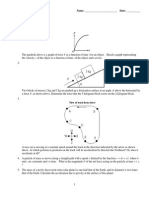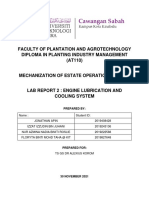Study Guide I
Study Guide I
Uploaded by
Luis Alberto Martínez BenítezCopyright:
Available Formats
Study Guide I
Study Guide I
Uploaded by
Luis Alberto Martínez BenítezCopyright
Available Formats
Share this document
Did you find this document useful?
Is this content inappropriate?
Copyright:
Available Formats
Study Guide I
Study Guide I
Uploaded by
Luis Alberto Martínez BenítezCopyright:
Available Formats
Study Guide
Topics to study: Vector characteristics. Vector examples: displacement, velocity, etc. The three Newtons Laws.
Physics II
Inertia. (remember that we said the inertia is related with the mass of the object)
Problems: A box is pulled over a surface has shown in the figure 1. The force exerted over the box is 350 N and is applied with an angle of 29 with the horizontal. If the box has a weight of 200N, what acceleration will occur over the box.
Solution: 1.- The force exerted over the box has an specific direction. In this case, it means that the acceleration it is not directly related with that force, because the acceleration we are looking for is horizontal. Has we are only concerned about the horizontal components; we have to use equation 9, which will obtain, only the horizontal component of that Force.
Fx F cos
Fx = (350 N)*cos(29)= 306.11 N
Has the second Newtons Law states: an object with a certain mass m, that receives a force F will accelerate with a magnitude of a. So we need to use equation 5; nevertheless, we actually dont know the value of that mass.
However, we know the value of the Weight, 200N. And knowing that, and using equation 10, where g is the value of gravity, we can obtain the value of that mass: W=m*g m=W /g m = 200N / 9.81 m/s2 = 20.39 kg
We can now use equation 5 where: F=m*a a = F / m a = 306.11 N / 20.39 kg = 15.01 m/s2 , which is the acceleration felt in the box horizontally.
Problem 2.- An automobile goes over Gonzalitos with a velocity of 130 km/h in a straight road and then applies the breaks and it stops in a distance of 350 meters. If the automobile weights 9810 N, a)What is the magnitude of the force for the automobile to stop? b)How many time it takes to the car to stop?
Solution: Again, the second Newtons Law relates the force (in this case applied by the breaks) felt by the car to stop, the mass of the car and the acceleration needed to stop. Neither the mass nor the acceleration are given directly in the data, we must obtain them first. Again, the mass is unknown, but the Weight is the value we can use to obtain the mass, again, using equation 10: W=m*g m=W /g m = 9810N / 9.81 m/s2 = 1000 kg
Now we need the acceleration, and the only values related to that are the velocity and the distance travelled. Has the problem says the car must stop, this means the final velocity of the car must be 0. So the equation that relates acceleration, final and initial speeds, and distance is equation 1. This is: V = Vo +2ad
2 2
but we want the acceleration
a = ( V - Vo )/ 2d
Dont forget that you CANT use km/hr for the velocity, you must change them into m/s. Vo = 130 km/hr = 36.11 m/s Now, substitute the values: a= ( 0 (36.11 m/s) ) / 2(350m) a = -1.86 m/s So this is the needed acceleration to stop from 130km/hr to 0. And using equation 5 for obtaining the force: F = m * a = 1000kg* (-1.86 m/s ) = - 1860 N
2 2 2
1) V = Vo + 2ad
2) V = Vo + at 3) d = Vot + at /2 4) d = ((V + Vo)/2) * t
5) F = m*a
tan 1
6)
Vy Vx
7) V =
2 2 Vox Voy
8)
Fy F sin
9)
Fx F cos
10) w = m*g
11) Vx = V*Cos 12)
Vy= V*Sin
You might also like
- Lesson 2 Topic 1 Physical Properties of Soil 1Document12 pagesLesson 2 Topic 1 Physical Properties of Soil 1Jhonalyn LumogdangNo ratings yet
- Lab 112 ReportDocument3 pagesLab 112 ReportKing100% (3)
- AP Physics Unit 2 QuizDocument11 pagesAP Physics Unit 2 QuizReddyvari VenugopalNo ratings yet
- Lab Report 2Document8 pagesLab Report 2minadiaNo ratings yet
- AssignDocument10 pagesAssignkakaNo ratings yet
- Physics 111 Homework Solution #5Document20 pagesPhysics 111 Homework Solution #5jhunNo ratings yet
- H2 Physics DynamicDocument22 pagesH2 Physics DynamicTa Minh Trang100% (1)
- Lab Report: Newton's Second LawDocument6 pagesLab Report: Newton's Second LawBrad Huang0% (1)
- The Addition and Resolution of Vectors Lab PracticeDocument2 pagesThe Addition and Resolution of Vectors Lab PracticeLuis Alberto Martínez BenítezNo ratings yet
- Water Cycle Test SchoologyDocument5 pagesWater Cycle Test Schoologyapi-241192726No ratings yet
- Shock Wave Reflection PhenomenaDocument353 pagesShock Wave Reflection PhenomenaAranya DanNo ratings yet
- Hvac Formula - Calculation of Heating, Cooling Degree DaysDocument1 pageHvac Formula - Calculation of Heating, Cooling Degree DaysDani HalimNo ratings yet
- Physics 1 Our ProjectDocument203 pagesPhysics 1 Our ProjectAviona LaycoNo ratings yet
- Class 9 Practical MathDocument7 pagesClass 9 Practical Mathsahonspondon4No ratings yet
- The Velocity Component Down The Slope Is V Sin (20) 16.2 Sin (20) 5.54m/s. Option CDocument6 pagesThe Velocity Component Down The Slope Is V Sin (20) 16.2 Sin (20) 5.54m/s. Option CNaeem GulNo ratings yet
- Physics 1120 Newtons Laws Solutions - CompressDocument32 pagesPhysics 1120 Newtons Laws Solutions - CompressTITO FAUZAN ADHIMNo ratings yet
- Ordinary Differential Equations2018Document22 pagesOrdinary Differential Equations2018pradika noviandaniNo ratings yet
- Physics 1100 Work & Energy SolutionsDocument19 pagesPhysics 1100 Work & Energy SolutionsAtchaya Pannir SelvamNo ratings yet
- Lesson 6 Example ProblemsDocument9 pagesLesson 6 Example ProblemsOksana MandrykNo ratings yet
- Home Work 5 - Chapter 5: SolutionsDocument6 pagesHome Work 5 - Chapter 5: SolutionssarahhNo ratings yet
- PCS120 Midterm Additional Review QuestionsDocument12 pagesPCS120 Midterm Additional Review QuestionsBetty WangNo ratings yet
- CH-6 Linear Momentum and Impulse-11 PDFDocument13 pagesCH-6 Linear Momentum and Impulse-11 PDFvic100% (3)
- Physics Assignment 1Document4 pagesPhysics Assignment 1Trí Võ PhạmNo ratings yet
- As 21c Motion&ForceDocument40 pagesAs 21c Motion&ForceHany ElGezawyNo ratings yet
- Guía PhysicsDocument31 pagesGuía PhysicsJojoNo ratings yet
- Assignment 1 Applied PhysicsDocument16 pagesAssignment 1 Applied PhysicsUsman ManiNo ratings yet
- Exercises - Chapter 02Document12 pagesExercises - Chapter 02Phong ĐâyNo ratings yet
- CH4 Recommended Problems PDFDocument3 pagesCH4 Recommended Problems PDFnomio12No ratings yet
- NCERT Solutions For Class 11 Physics Chapter 5 Laws of MotionDocument29 pagesNCERT Solutions For Class 11 Physics Chapter 5 Laws of MotionCREATIVE XNo ratings yet
- Physics 121.6 2007/2008: Assignment 4 - SolutionsDocument8 pagesPhysics 121.6 2007/2008: Assignment 4 - SolutionsLuwakCoffeenya YHogiNo ratings yet
- UntitledDocument18 pagesUntitledYhace CaranguianNo ratings yet
- Objective Type Questions: F Ma A 30 30Document12 pagesObjective Type Questions: F Ma A 30 30mahishan344No ratings yet
- Example: Given: A 0.5 KG Ball of Negligible SizeDocument9 pagesExample: Given: A 0.5 KG Ball of Negligible SizegNo ratings yet
- 9-51 AnswersDocument1 page9-51 AnswersannoyonamusNo ratings yet
- Force & Laws of Motion Numericals SolutionDocument10 pagesForce & Laws of Motion Numericals SolutionViji GowriNo ratings yet
- Net 1 Net 2 Net w1 Net w2 1 1 2 2Document6 pagesNet 1 Net 2 Net w1 Net w2 1 1 2 2Cylle Jerone BuenviajeNo ratings yet
- Energy 7.6 Potential and Kinetic EnergiesDocument9 pagesEnergy 7.6 Potential and Kinetic EnergiesOnur YavuzcetinNo ratings yet
- Newtons Law of MotionDocument25 pagesNewtons Law of MotionJoca RiveraNo ratings yet
- Dynamics NotesDocument11 pagesDynamics NotesRyan TanNo ratings yet
- Today: Homework Due Conservation of Energy Read Chap 13, Sections 6 To 9 Homework: Chap. 13, Problems 57, 61, 67, 76Document12 pagesToday: Homework Due Conservation of Energy Read Chap 13, Sections 6 To 9 Homework: Chap. 13, Problems 57, 61, 67, 76Tony LoogmanNo ratings yet
- Momentum Review QuestionsDocument5 pagesMomentum Review Questionssomeguy01123No ratings yet
- JEE Main 2024 Question Paper With Solution Jan 27 Shift 1Document22 pagesJEE Main 2024 Question Paper With Solution Jan 27 Shift 1niharika.alakuntaNo ratings yet
- Giancoli Prob - Solution Chap.7Document8 pagesGiancoli Prob - Solution Chap.7Rajesh KumarNo ratings yet
- Force and Motion: Younes SinaDocument42 pagesForce and Motion: Younes SinayounessinaNo ratings yet
- Free Falling BodiesDocument8 pagesFree Falling BodiesGeralyn PalambianoNo ratings yet
- Chapter #7 Giancoli 6th Edition Problem SolutionsDocument8 pagesChapter #7 Giancoli 6th Edition Problem SolutionsbongumanNo ratings yet
- (A) What Is The Magnitude of The ResultantDocument4 pages(A) What Is The Magnitude of The ResultantAadar NNo ratings yet
- Physics ProblemsDocument19 pagesPhysics ProblemsArthur1966100% (1)
- NCERT Solutions For Class 11 Physics 12 May Chapter 5 Laws of MotionDocument29 pagesNCERT Solutions For Class 11 Physics 12 May Chapter 5 Laws of Motiondaksh tyagiNo ratings yet
- Ordinary Differential Equations2018Document22 pagesOrdinary Differential Equations2018syarifNo ratings yet
- Dinamika PartikelDocument34 pagesDinamika PartikelRizky Syahreza RyaldiNo ratings yet
- Thermodynamics Lecture NotesDocument99 pagesThermodynamics Lecture NotesVedansh VedNo ratings yet
- Experiment 104: Newton's Second Law of MotionDocument7 pagesExperiment 104: Newton's Second Law of MotionJaz DionisioNo ratings yet
- Example Sheet 1 SolutionsDocument5 pagesExample Sheet 1 SolutionsDominic Dela CruzNo ratings yet
- Chap6 PhysicsDocument23 pagesChap6 PhysicsMadhavi SivanNo ratings yet
- Momentum Practice SolutionsDocument15 pagesMomentum Practice SolutionsMax Derp NgNo ratings yet
- 221HCh04 PDFDocument25 pages221HCh04 PDFisele1977No ratings yet
- Measurement.: Nombre: - Grupo: - Evidence 5Document2 pagesMeasurement.: Nombre: - Grupo: - Evidence 5Luis Alberto Martínez BenítezNo ratings yet
- Measurement and UncertaintyDocument9 pagesMeasurement and UncertaintyLuis Alberto Martínez BenítezNo ratings yet
- Nombre: - Grupo: - Evidence 3 - Report From "Lab Material & Equipment" Laboratory ActivityDocument1 pageNombre: - Grupo: - Evidence 3 - Report From "Lab Material & Equipment" Laboratory ActivityLuis Alberto Martínez BenítezNo ratings yet
- Portafolio 1Document1 pagePortafolio 1Luis Alberto Martínez BenítezNo ratings yet
- Measurement in LaboratoryDocument6 pagesMeasurement in LaboratoryLuis Alberto Martínez BenítezNo ratings yet
- Acitvity 3 of The Portfolio 2Document1 pageAcitvity 3 of The Portfolio 2Luis Alberto Martínez BenítezNo ratings yet
- Cover of Portfolio 4 Physics 2,2012Document1 pageCover of Portfolio 4 Physics 2,2012Luis Alberto Martínez BenítezNo ratings yet
- Universidad Autónoma de Nuevo León: Centro de Investigación Y Desarrollo de Preparatoria BilingüeDocument4 pagesUniversidad Autónoma de Nuevo León: Centro de Investigación Y Desarrollo de Preparatoria BilingüeLuis Alberto Martínez BenítezNo ratings yet
- Force 2Document29 pagesForce 2Luis Alberto Martínez BenítezNo ratings yet
- Practice Lab # 3Document2 pagesPractice Lab # 3Luis Alberto Martínez BenítezNo ratings yet
- Cover of Portfolio 2, 2012Document1 pageCover of Portfolio 2, 2012Luis Alberto Martínez BenítezNo ratings yet
- Lab Report 2Document3 pagesLab Report 2Luis Alberto Martínez BenítezNo ratings yet
- Vectors Stool ActivityDocument2 pagesVectors Stool ActivityLuis Alberto Martínez BenítezNo ratings yet
- Vectors 1Document1 pageVectors 1Luis Alberto Martínez BenítezNo ratings yet
- Bab 5 Hal 128-129Document2 pagesBab 5 Hal 128-129Dio Izqhaq Risky SasongkoNo ratings yet
- Types of CementDocument12 pagesTypes of Cementsher afganNo ratings yet
- Implicit - LES Implicit Large Eddy SimulationDocument577 pagesImplicit - LES Implicit Large Eddy SimulationSofian SalmaniNo ratings yet
- Bridge Rehabilitation 1479417650Document30 pagesBridge Rehabilitation 1479417650Lengendary PhubrNo ratings yet
- 1.2 Strength of MaterialsDocument27 pages1.2 Strength of MaterialsAtul PandeyNo ratings yet
- Tensile LabDocument13 pagesTensile LabnevermoreNo ratings yet
- The Effect of Particles On Surface Tension and Flotation Froth StabilityDocument7 pagesThe Effect of Particles On Surface Tension and Flotation Froth StabilityJaime Omar Godinez RevelesNo ratings yet
- TS Pa6 GFDocument20 pagesTS Pa6 GFadiNo ratings yet
- Correccion de Termometro de Radiacion - TG15-Version-2-December-2017Document4 pagesCorreccion de Termometro de Radiacion - TG15-Version-2-December-2017RONALD ALFONSO PACHECO TORRESNo ratings yet
- Manual XV Gig - enDocument32 pagesManual XV Gig - enWendel Soares CorreiaNo ratings yet
- Diagramas de Pourbaix 2018Document72 pagesDiagramas de Pourbaix 2018Leo RodgersNo ratings yet
- CLOMATOLOGY PART 2 NetsetcornerDocument15 pagesCLOMATOLOGY PART 2 Netsetcornersinghsitu51No ratings yet
- Physics 2 GRADE 12 Lesson 1 Electric Charge, Force and FieldsDocument8 pagesPhysics 2 GRADE 12 Lesson 1 Electric Charge, Force and FieldsAryhen Dela CruzNo ratings yet
- 结构化学Document2 pages结构化学Ruonan QinNo ratings yet
- Physics: Pearson EdexcelDocument28 pagesPhysics: Pearson EdexcelAbdulrahim SaiidNo ratings yet
- Deck Cross Beam - 25 - 5 - 2022Document14 pagesDeck Cross Beam - 25 - 5 - 2022thazinNo ratings yet
- Classification of Solar Collectors: Žanis JeskoDocument6 pagesClassification of Solar Collectors: Žanis JeskoKaushik SheetNo ratings yet
- Engineering Physics - I: Set No. 1Document8 pagesEngineering Physics - I: Set No. 1Nanda KumarNo ratings yet
- Quiz DRRRDocument3 pagesQuiz DRRRGlenn Cacho Garce100% (6)
- Tutorial 2Document3 pagesTutorial 2kz_kamranNo ratings yet
- Mechanics of Solids PDFDocument8 pagesMechanics of Solids PDFprashanthreddy26No ratings yet
- Teflon (PTFE) Data SheetDocument1 pageTeflon (PTFE) Data SheetMarisa Yuni Nur AzizaNo ratings yet
- Beam Pre StressDocument55 pagesBeam Pre StresssurangaNo ratings yet
- Behavior of Steel Fiber Reinforced Concrete Beam Using Fly AshDocument11 pagesBehavior of Steel Fiber Reinforced Concrete Beam Using Fly AshAhmad YaniNo ratings yet
- LG Total Hvac Solution ProviderDocument48 pagesLG Total Hvac Solution ProviderSkylarNo ratings yet








































































































